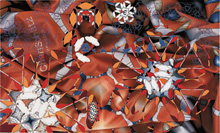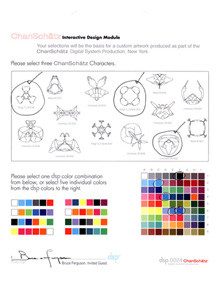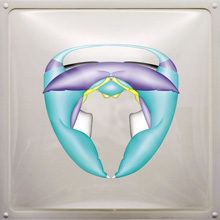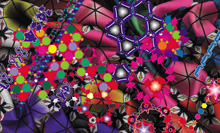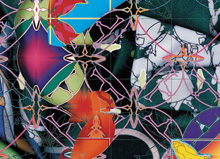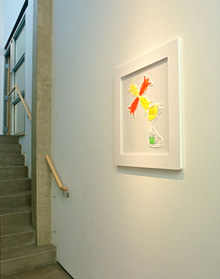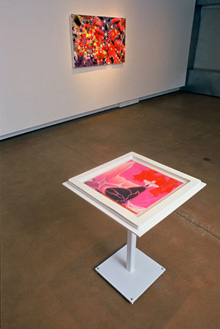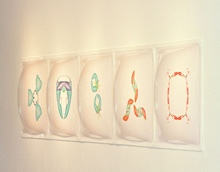ChanSchatz
September 7 - October 20, 2001
"It is not the passion…for substances that speaks in fetishism, it is the passion for code."
--Jean Baudrillard Graphics, in the broadest sense, are a technology for representing or otherwise facilitating the display of information. A photograph enables images made from natural light. A phonograph allows sound to be amplified. Computer graphics, for their part, facilitate representations made from digital or alphanumeric code. It is crucial to note that a computer graphic is not the same as a computer image: the former is a set of instructions - a software or algorithm - the latter is a visual form produced by these instructions. The philosopher and historian of media, Freidrich Kittler, reminds us that computer graphics arose not out of television or Disney-style animation as might be assumed, but out of radar, the tracking of points on a plane over a duration, a technology of war. The original computer graphics were white dots on a black or green screen - enemy planes or missiles, submarines, mobile resources, characters or ciphers in a dramatized field of action - and as such, had to be able to pin-point space as it changed, adapting representation to situation, context, and time. With the creation of the World Wide Web in the 1990s, computer graphics completed the familiar arc from military to commercial applicability, and have today become the most immediate enabler of the Internet’s image-field of commodities and personal communication.
As such, computer graphics have entered what might be called their "fetish stage." Typically defined as objects or images embodied with powers to channel or proximate a sublimated desire - whether cultural, economic, sexual, or religious - fetishes are themselves technologies built around needs. In a digital era mesmerizing in its ability to make its meanings and values seem both everywhere and nowhere at once, computer graphics play a crucial role in allowing individuals to assuage their anxious relationships to its images. Consumer-ready software like Photoshop and Flash and relatively simple graphics-enabling programming languages like HTML and Java assure that we are no longer merely receivers of transmitted visual data (as in the "broadcast age" of TV), but that we now feel connected in a literal sense to the production and transmission of culture. Like the original military graphics, computer graphics let us customize information according to our needs and desires. The graphic fetish, which is also evident in the massive popularity of cartoon collectibles like Pokémon or in the branding logic that drives Martha Stewart to put her name and logo on everything under the sun, is a kind of therapeutics of representation. By controlling or personalizing the technology of the image, the graphic fetish grants us the illusion of a more meaningful relationship to the image of technology.
For over ten years, the artist duo ChanSchatz (Eric Chan and Heather Schatz) have been producing one of the most complex and obsessive art and technology projects of its time, one that might be likened to a kind of taxonomy of graphical fetishes. Fundamentally conceptual in nature, ChanSchatz don’t have any signature media, though they "output" their work quite variously by means of digital animation, textile design, and quasi-sculptural constructions made from layered inkjet prints hung on walls. In all cases, their work is driven by its fetishization of graphical forms and techniques. The print-construction DIS.02 IDM: dfisher>pshipman>pschonberger, for instance, is a kaleidoscopic explosion of shapes, colors, logos, and other, less identifiable, marks. Its visual contents seem barely contained by its frame. Its ground is comprised of a digitally scanned image of a ChanSchatz "scarf" - one of the apparel items the artists graphically customize according to a template of forms and color schemes (called an “Interactive Design Module”) chosen by an invited guest. The bunched folds of the scarf and the visible stitching and weave of its silk fabric lend an illusion of photographic depth to the image, though no photo-mechanical process was used in its making. On the "surface" of the print, bursts of fractal-like geometric figures form patterns that evoke insects, jewelry, wallpaper, or flowers. With inspection, the figures can be seen to mirror or play off the graphical motifs of the scarf-ground, lending the total image a highly self-reflexive quality. Adding even further complexity to the image, portions of the print surface have been cut away to expose stratified, canyon-like under layers equally dense with graphical figures. The overall image appears frozen, static, and topological, as if a dynamic three dimensional system full of internal relationships has been screen-grabbed in mid-flow.
Some brief background: Like so many cultural producers these days - think of the DJ, or the computer programmer, or even of a Pop artist like Warhol - ChanSchatz work from an archive, a database, of pre-existing forms. Unlike other contemporary samplers though, ChanSchatz’s database is neither a repository of culture (like that of the Pop artist or DJ), nor a toolbox of functionally encoded data (like that of the programmer). Comprised of simple gestalt shapes reminiscent of architectural drawings, the visual content of the ChanSchatz database is purely formal and graphical. Through a process not unlike collage, ChanSchatz "evolve" rudimentary forms into an archive of typological and morphological data the complexity of which can be seen in the assemblage-figures of a print like DIS.02 IDM: dfisher>pshipman>pschonberger. From a few basic graphics, color combinations, and strategic design implementations, an entire network of relationships has grown - a bit like an ecosystem coming to life.
All of ChanSchatz’s rendered artwork derives from its database. None of the visual content of the inkjet prints, digital animations, or fashion accessories (which includes ties, and soon, underwear, in addition to the scarves) is photo-based or appropriated from culture. Nor are the graphical forms indexical or depictive of anything beyond their own language of code. ChanSchatz’s self-generating and self-contained database allows them to venture into a truly new kind of technological abstraction. Instead of relating directly or metaphorically to the world, the various outputs of ChanSchatz’s database relate, obsessively and solipsistically, to the processes and contexts of their own production. Simply stated, the artists have produced a system for depicting production in a digital environment.
ChanSchatz have recently begun making digital animations, time-based siblings to their prints. Though a given print and a given animation will often share visual motifs, the same specific textile ground for instance, or the same set of figures, it is difficult to say if one media is based upon the other. Are the prints static moments of an animation, or are the animations simply moving and extrapolated versions of the prints? Such questions are beside the point - what is important is that the two media both reference the ChanSchatz database, just in different ways. For their part, the animations tend to literalize the notion of performance and interaction implicit to the database as an evolutionary archive. It might be said that ChanSchatz’s animations "realize" or activate the graphical relationships evident allegorically in their prints. Pushing and pulling the viewer towards a narrativization of their system, the animations are perhaps analogous to theater or cinema whose plot has been stripped of meaning and reduced to simply exhibiting change as a generic constant.
MOV. 02 IDM:bstein>dgoldberg>ajaffe, for example, seems a kind of window onto an insect colony or an airport buzzing with inscrutable, highly ritualized, movements. The animation is set on a loop, though the finitude of its duration is indeterminate given the specificity and intricacy of the graphical action happening within and apparently outside of its frame. The graphical figures which skit or float across the image plane may be read as characters whose "behaviors" or characteristics have been somehow predetermined or delimited in conjunction with their formal properties. Some figures lumber slowly by themselves, others move in phalanxes or teams and flutter rapidly amongst their neighbors. A "soundtrack" designed by R. Luke DuBois, adds an audio profile to the graphical profile of each character - a drone for the bulbous, slow snowflake shape; arrhythmic bongo claps for the flapping chevrons - and underscores the essentially rhetorical nature of this system. Watching ChanSchatz’s animations is not exactly like watching a movie however. The characters’ movements and graphical attributes are less anthropomorphized than abstract. They signify scale, composition, formal generation, comparison, and contrast, rather than the emotion, morality, and culture that are offered by cinema’s illusionistic realism. They may, in a distant way, be kin to the abstract representations one finds in video games or chess, though even in these systems characters tend to stand for human behaviors, social ranks, and thematized actions.
ChanSchatz’s animations show us a system of information generating itself. What is fetishized in this system is less the individual graphical image than the dynamic process of transformation and customization exemplified by the building of graphical relationships over time. The graphic in ChanSchatz’s work always stands for or emblematizes this process, which is perhaps most precipitously analogous to the world and language of commerce. Customization itself is almost axiomatic to the commodity form in the age of brand "tie-ins" and niche marketing. Like Beanie Babies or Transformer robot toys, ChanSchatz’s graphical database constantly updates its primary elements into newer, more hybridized extensions of its essential image. The “Interactive Design Modules” ChanSchatz use to let invited guests determine the graphical content of their textiles suggest the focus-group exercises businesses administer to fine-tune their products to consumer desire and increasingly specialized markets. Even their name, ChanSchatz, which is applied as a graphical element in its own right to their prints and textiles, resonates with the compounded abstraction of a corporate logo.
Ultimately, it must be remembered that ChanSchatz’s project belongs nominally and contextually to "art" rather than commerce, even as these once autonomous spheres can be seen to collapse into each other with increasing frequency. The issue of art’s fetishization of technology has had a long and highly contentious history in twentieth century art discourse and criticism (it may even be said to form the core problematic in Benjamin Buchloh’s dialectical appraisal of post-war art). 5 From Duchamp’s readymades and Constructivism’s use of commercial and graphic design, through Minimalism’s privileging of industrial materials like steel, Styrofoam, and Plexiglas, to digital art’s exploration of consumer-ready new media, art’s fetishism of technology has been variously critical or avant-gardist, celebratory, naïve, cynical, or merely symptomatic. At this moment, however, perhaps only in the realm of architecture and design can the technological fetish still proclaim the vestiges of avant-gardist functionality and transparency that have, in Hollywood and the Web as much as in art, been given over to the ideological and commercial imperatives of entertainment and spectacle.
The proximity of ChanSchatz’s fetish graphics to design makes their project
a special case in art. Though they make full use of the techniques and aesthetics of the digital culture industry - graphics programs, allover compositions of blobby or techno forms, nods to fashion, commodities, and brand networks - ChanSchatz’s fetishes seem positive and generating. Far from signaling a simple mesmerization with the current culture’s flux and flow of newly technologized commodity images, ChanSchatz seem instead to be reinvigorating modernism’s century-old experiment with the human uses of abstraction; but crucially, from a standpoint unencumbered by the past. Their project offers the possibilities of process rather than the symptomologies of products. It suggests a way of learning or relearning a kind of relational intelligence or "visual skills" whose meanings and values have been newly expanded by the complexities of technology and culture. What kind of critical intelligence this intelligence will yield vis-à-vis art is still an open question, and should be for some time to come.
Bennett Simpson
August 2001
New York
1 Jean Baudrillard, Fetishism and Ideology (1981), quoted in Benjamin Buchloh, "Parody and Appropriation in Francis Picabia, Pop, and Sigmar Polke" in Neo-Avantgarde and Culture Industry (Cambridge, MA. MIT Press, 2000): 343.
2 Freidrich Kittler, "Computer Graphics: A Semi-Technical Introduction," Grey Room 2 (Winter 2001): 30-45.
3 For further discussion of ChanSchatz’s project see my essays "The Law of Large Numbers: ChanSchatz and the Production of Production" in Artbyte vol. 1, no. 4 (Sept.-Oct. 1998): 48-52; and "Seeking a New Aethetic of Information" in the online magazine Feed http://www.feedmag.com, Sept. 15, 1999. See also "Fine Artists in the Digital Age: An interview with ChanSchatz" at Fathom http://www.fathom.com, an interactive learning database joint operated by Columbia University, the London School of Economics and Political Science, Cambridge University Press, The British Library, The Smithsonian Institution, and The New York Public Library.
4 ChanSchatz’s long and conpounded titles indicate the database "lineage" or genealogy of a given work’s graphical content. The proper names in the titles refer to the guests invited by the artists to work with their "Interactive Design Modules."
5 See especially Benjamin Buchloh, Neo-Avantgarde and Culture Industry, throughout.
Back to top

|
|




